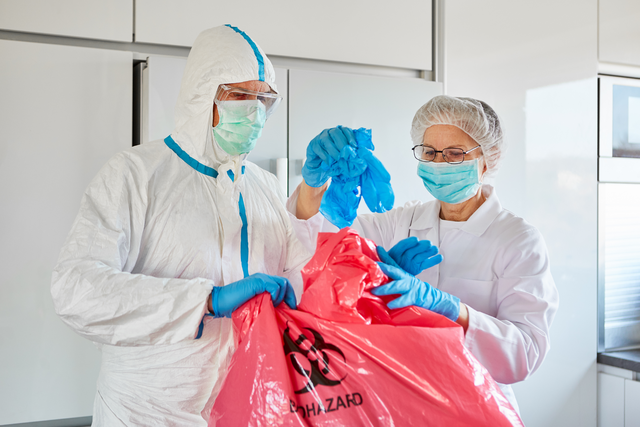There’s no denying the positive impact of chemotherapy over the past 50 years. It’s a pivotal treatment tool in the fight against cancer on a global scale, with over half of all cancer cases worldwide – 9.8 million out of 17 million – requiring chemotherapy. And that number is only expected to rise, with recent projections suggesting the number of new cancer patients needing chemotherapy to rise to 15 million by 2040. As beneficial as the treatment will be for cancer patients and their families, its proliferation poses a serious risk to the environment when it comes to chemotherapy waste disposal.
In this blog, we’ll be exploring the risks that improper chemotherapy waste disposal poses to natural habitats and ecosystems, as well as highlighting the need for more sustainable chemotherapy waste treatment practices.
What Is the Environmental Risk of Improper Chemotherapy Waste Disposal?
Cascades of environmental problems are associated with the improper disposal of chemotherapy waste. When the toxic substances from both bulk and trace chemotherapy waste seep into soil and water, they don’t just disappear – they disrupt plant and aquatic life, affecting the ecosystem and creating reproductive issues for some wildlife. This can have ripple effects up the food chain, effects that can potentially even reach the dinner table! The common practice of burning this waste, when done without careful controls, can be exceedingly dangerous, too, sending harmful pollutants into the air that may affect the health of nearby communities.
What is the Difference Between Bulk and Trace Chemotherapy Waste?
Bulk chemotherapy waste includes items such as absorbent PPE that has been saturated with chemotherapy agents and partially used or expired vials of the potent anti-cancer drugs. Trace chemotherapy waste, on the other hand, consists of PPE items such as gloves and gowns, as well as empty IV bags, tubing, syringes, vials and other containers that once held chemotherapy drugs.
Is Trace Chemotherapy Waste Hazardous?
Because chemotherapy drugs are cytotoxic (meaning they kill cells), it’s not difficult to see how bulk chemotherapy waste disposal can be harmful to both human health and the environment. But a lot of medical professionals have questions about whether trace chemotherapy poses the same threat to our natural habitats. Well, the answer, unfortunately, is an undeniable “YES.”
Sustainable Waste Management Practices for Chemotherapy Drug Disposal
When it comes to chemotherapy disposal guidelines, the focus needs to be on reducing the environmental impact of disposal while ensuring human safety and legal compliance with state and federal regulations. Here’s seven suggestions to help your facility engage in more sustainable waste management practices:
- Educate and Train Staff: The more you know, right? Regular training for your healthcare staff on proper waste handling and disposal procedures is critical, not only for compliance issues, but also in driving awareness of the environmental risks posed by both bulk and trace chemotherapy waste.
- Focus on Waste Minimization: Reducing the amount of waste generated is perhaps the key to a sustainable process. You can achieve this through being more precise in the preparation of chemotherapy drugs, thereby avoiding excess, and by using drug delivery systems that minimize residue left in containers and tubing.
- Always Segregate Waste: Separating hazardous chemotherapy waste from non-hazardous waste is a must when it comes to managing chemotherapy waste more sustainably. This involves segregating waste at the source to both minimize the volume of hazardous waste and reduce treatment costs.
- Use Approved Containers Only: It’s important to only use approved containers that are specifically designed for chemotherapy waste – and make sure they’re puncture-resistant, leak-proof, and clearly labeled!
- Consider Alternative Treatment Technologies: New treatment techniques such as advanced oxidation processes, microwave-induced pyrolysis, or plasma pyrolysis can be more sustainable chemotherapy waste disposal practices than incineration, which can release harmful emissions.
- Follow Regulatory Compliance: Adhering to local and international regulations for hazardous waste management will not only ensure that legal compliance is adhered to, but it also supports sustainable practices by enforcing standards that prevent environmental contamination.
- Collaborate with a Waste Management Professional: Partnering with a specialized waste management company that focuses on sustainable practices, such as Superior Medical Waste Disposal, can help healthcare providers manage chemotherapy waste more effectively and sustainably.
At Superior Medical Waste Disposal, our seasoned professionals are experts in hazardous waste knowledge, including chemotherapy waste disposal, and we are up-to-date on all related compliance laws. If your medical facility needs assistance in storing, transporting, or disposing of both bulk and trace chemotherapy waste, reach out today for a free consultation.
